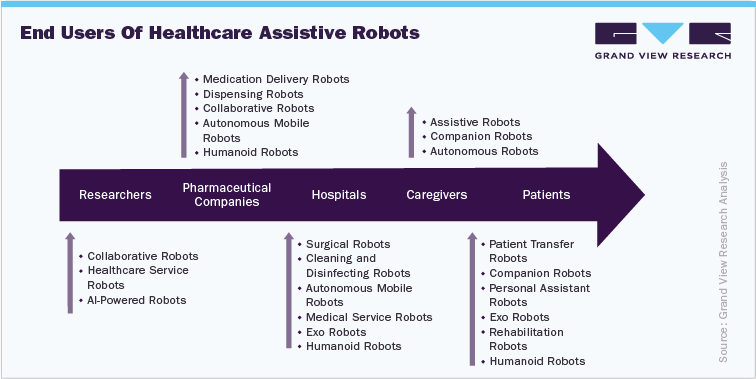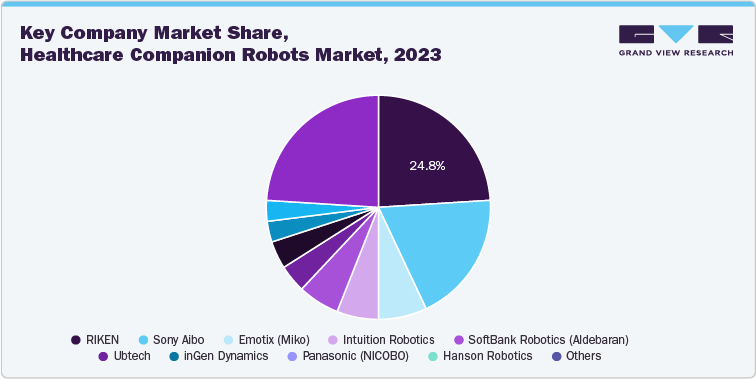1.1 Healthcare Assistive Robots Market
The global healthcare assistive robots market size was estimated at USD 27.3 billion in 2023 and is projected to grow at a CAGR of 16.6% from 2024 to 2030. The market encompasses a range of segments such as surgical, exoskeleton, pharmaceutical, cleanroom, prosthetics, medical service, and companion robots. This trend report from the GVR research team will deliver comprehensive qualitative and quantitative insights specifically on the surgical, exoskeleton, medical service, and companion robots segments.

1.2 Healthcare Companion Robots Market Share Analysis - Healthcare Assistive Robots Market
The healthcare companion robots market was estimated at USD 1.8 billion in 2023 and is anticipated to witness the fastest CAGR over the forecast period. The market is expected to witness significant growth in coming years owing to various factors such as:

-
In March 2024, Franka Robotics, a company developing robotics technologies featuring human-like tactile abilities, launched the Franka AI Companion. This innovative tool, with its advanced hardware and software capabilities, is created to support robotics researchers and represents a breakthrough in research productivity and creative potential in robotics.
-
In January 2024, Intuition Robotics, a leader in AI technology for seniors, announced significant updates and improvements to its AI companion, ElliQ. This latest version, ElliQ 3, marks a substantial advancement in incorporating generative AI into daily living, transforming the dynamics of human-AI interactions. Backed by a USD 25M funding boost, the upgrades include enhanced hardware and software features, enabling Intuition Robotics to increase the reach and accessibility of ElliQ. These enhancements aim to increase the autonomy and well-being of older people while also reducing experiences of isolation.
1.3 Healthcare Companion Robots Market Drivers and Opportunities
-
Aging Population: The increasing number of elderly globally is a primary driver of demand for healthcare companion robots. This population requires assistance with daily activities, cognitive support, and companionship, which these robots can provide.
-
Technological Advancements: Innovations in robotics and artificial intelligence are enhancing the capabilities of companion robots, making them more effective in assisting users. Developments such as AI-driven care robots and humanoid designs are gaining traction. For instance, in July 2020, Milagrow, an Indian company specializing in consumer robots, launched four new humanoid robots: RoboJulia, RoboNano, RoboElf, and RoboDiCaprio. These robots specifically aim to serve the needs of hotels, hospitals, restaurants, and corporate offices. To meet this rising demand, particularly in the healthcare, hospitality, and office management sectors, Milagrow has introduced these four humanoid robots.
-
Government Initiatives: Various governments are promoting companion robots to address healthcare challenges, especially in regions with many elderly residents. Initiatives in South Korea and New York State aim to integrate companion robots into elder care systems. For instance, The NYSOFA and Intuition Robotics have extended their joint effort and shared new insights into the success of providing AI-powered companionship for senior citizens in New York State. These insights include a significant 95% reduction in loneliness among the elderly and high levels of interaction. Over the past year, through a pilot program, NYSOFA and Intuition Robotics have introduced more than 800 people to ElliQ, an innovative, understanding, and initiative-taking AI companion. This venture aimed at lessening feelings of isolation, encouraging active participation, boosting health and wellness, and supporting older people living independently.
-
Rising Disposable Income: As disposable incomes increase, more individuals can afford advanced healthcare technologies, including companion robots, which enhance their market penetration.
-
Impact of COVID-19: The pandemic highlighted the need for remote care solutions and companionship for isolated individuals, further accelerating the acceptance and demand for healthcare companion robots. For instance, in June 2020, A pediatric clinic in Armenia conducted trials with a robot companion named Robin, which led to notable improvements in the appetite and mood of child patients following their interaction with the robot.
-
Support for Individuals with Disabilities: The prevalence of disabilities also drives demand, as companion robots can significantly improve the quality of life for individuals facing these challenges. For instance, Under the National Robotics Initiative (NRI), the National Institutes of Health has declared its intention to back the creation of three novel co-robots designed to work alongside humans. These include two robots aimed at enhancing the health and living standards of people with disabilities and a third intended as a social companion to children, to foster curiosity and impart values related to diligence and perseverance. The support for these NIH projects is projected to reach around USD 2.2 million over five years, contingent on fund availability.
1.4 Healthcare Companion Robots Market Competition Mapping

1.5 Healthcare Companion Robots Market Emerging Trends
1. Companion Robots as Care Coordinators
- Trend: Companion robots are evolving from passive companions to active care coordinators, integrating with electronic health records (EHRs) and telemedicine platforms.
2. The Role of Companion Robots in Chronic Disease Management
- Trend: Companion robots are increasingly being used to support individuals with chronic diseases, providing reminders, monitoring symptoms, and even facilitating physical therapy.
3. Biofeedback-Driven Companion Robots
- Trend: The integration of biofeedback sensors in companion robots allows them to respond dynamically to the user’s physiological state, such as stress levels, heart rate, and emotional cues.
4. Expanding Roles beyond Companionship
- Trend: Companion robots are evolving to take on more complex roles, such as medication reminders, emergency alerts, and even physical assistance.
5. Integration with AI and Machine Learning
- Trend: AI and machine learning are being integrated into companion robots to improve personalized care and predictive health monitoring.
1.6 Different Types Healthcare Companion Robots and their Comparative Analysis
|
Type of Companion Robot |
Examples |
Applications |
Strengths |
Weaknesses |
|
Social Companion Robots |
|
|
|
|
|
Health Monitoring Companion Robots |
|
|
|
|
|
Assistive Companion Robots |
|
|||
|
Telepresence Companion Robots |
||||
1.7 Healthcare Companion Robots Market: Case Study
1.7.1 Case Study 1
The case study focuses on the implementation of the humanoid robot Pepper at St. Marien Hospital in Cologne, Germany, highlighting the challenges faced by the healthcare facility and the innovative solutions provided by SoftBank Robotics in collaboration with ENTRANCE Robotics.
About the Client
St. Marien Hospital has been serving the community for over 140 years, emphasizing modern treatment methods and compassionate care. Managed by the Poor Sisters of St. Francis for more than a century, the hospital became part of the Cellite Foundation network in 2004.
Client's Challenges
The hospital faces significant challenges due to:
-
A global shortage of approximately 12.9 million skilled health professionals by 2023.
-
An anticipated decline in the labor workforce by one-third by 2060 if immigration policies remain unchanged in Germany.
-
An uneven distribution of healthcare staff within the hospital.
-
The need for financial viability in healthcare operations.
-
The psychological impact of isolation on elderly patients.
Solution
To address these challenges, ENTRANCE Robotics developed the Robot.Care platform, which utilizes Pepper to provide various services:
-
Emotional Detection: Pepper can assess patient moods and adapt interactions, accordingly, enhancing emotional support and safety.
-
Fitness Activation: The robot serves as a personal trainer, offering individualized exercise programs to promote physical health.
-
Cognitive Activation & Dementia Prevention: Through interactive activities such as games and music, Pepper engages patients to stimulate cognitive functions and prevent dementia.
-
Telepresence: The robot facilitates communication between isolated patients and their families, reducing feelings of loneliness.
Results
The deployment of Pepper has yielded positive outcomes, with feedback from hospital staff indicating that the robot is perceived as empathetic and supportive. Notable results include:
-
General Supervision Time: 3 hours per day.
-
Group Program Movement: 30 minutes per day.
-
Individual Visits & Telepresence: 1.5 hours per day.
-
Total Accumulated Support: 155 hours per month.
Prof. Dr. Schulz, Chief Medical Officer at St. Marien Hospital: “Pepper is to be integrated as a partner that gives us the information we can’t get otherwise.”





